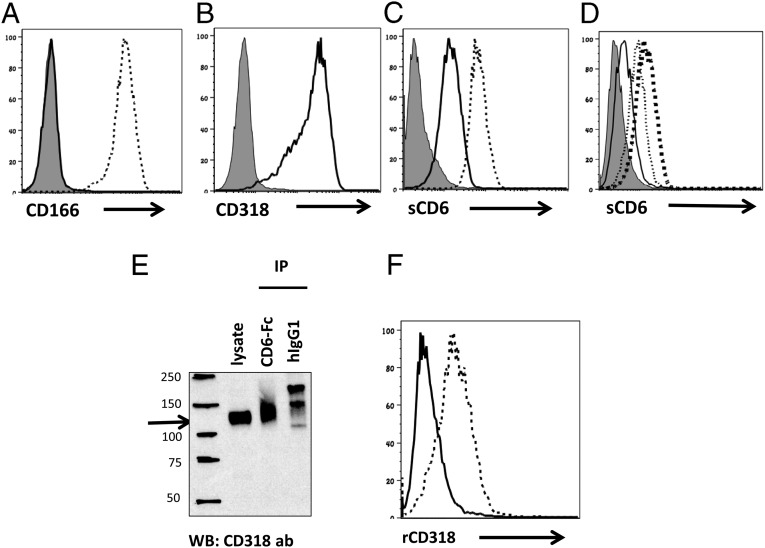Fig. 4.
CD6 interacts with CD318. (A) HT1080 CD166 KO cells are deficient of CD166. The CD166 KO cells were analyzed for CD166 expression by flow cytometry. Thin line, isotype control; thick line, CD166 KO cells stained with an anti-CD166 mAb; thin dash line, WT HT1080 cells stained with the anti-CD166 mAb. Data are representative of five independent experiments. (B) HT1080 CD166 KO cells express CD318. The CD166 KO cells were analyzed for CD318 expression by flow cytometry using the anti-CD318 mAb. Thin line, isotype control; thick line, CD166 KO cells stained with the anti-CD318 mAb. Data are representative of five independent experiments. (C) CD6 binds to WT and CD166 KO cells. WT and CD166 KO cells were incubated with the same concentrations of human IgG1 (control) or recombinant human CD6-Fc fusion protein (1 µM), followed by detecting the cell surface-bound CD6 using an Alexa488-anti-human IgG Ab. Thin line, isotype control; thick line, CD166 KO cells stained with CD6; thin dashed line, WT cells stained with CD6. Data are representative of six experiments. (D) Binding of CD6 onto CD166 KO cells is competitively inhibited by soluble CD318. CD166 KO cells were incubated with recombinant human CD6-Fc fusion protein (1 µM) in the presence of different concentrations of recombinant soluble CD318 (0, 1, and 3 µM), then level of cell surface-bound CD6 was quantitated by flow cytometric analysis after staining the cells with an Alexa488-anti-human IgG Ab. Thin shaded line: isotype control; thick dash line, no rCD318; thin dash line, 1 µM CD318; thin line, 3 µM rCD318. The numbers in parentheses represent the molar concentrations of either rHCD6 or rCD318. Data are representative of six independent experiments. (E) CD6 immunoprecipitates CD318 from the CD166 KO cell lysates. CD166 KO cell lysates were immunoprecipitated with the same concentrations of either soluble CD6 or human IgG1, then the immunoprecipitates were separated by SDS/PAGE and probed with the anti-CD318 Ab, showing that CD6 selectively pulled down CD318 (arrow). Data are representative of eight independent experiments. (F) Soluble CD318 binds to CHO cells that express CD6 on the surface. Control CHO cells (solid line) and CHO cells expressing human CD6 (dotted line) were incubated with recombinant CD318. After washing, the binding of CD318 on the cell surface was assessed by flow cytometry after staining the cells with the anti-CD318 mAb.

